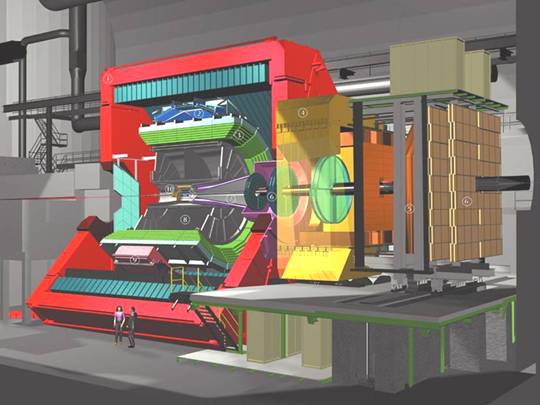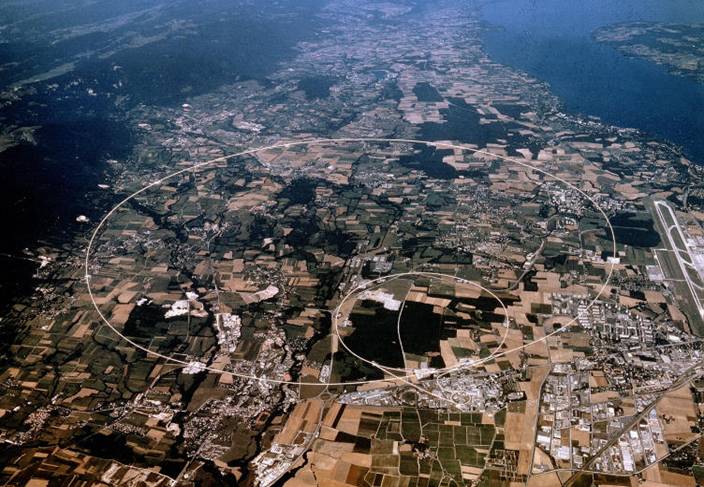Research
Ultra Relativistic Heavy ion Collision (Experiment)
Current understanding tells us that Universe was created about 13,700,000,000 years ago when the Big Bang created the space and time. Then it cooled and the building blocks of matter were created. After about 0.000001 second protons and neutrons were formed and nuclei were formed after about 3 minutes. After about 1.6 million years gravity came into action and led to the formation of all the celestial bodies.
 Within the first microsecond of the Big Bang, it is believed that matter existed as an extremely hot, dense soup called Quark Gluon Plasma where the quarks and gluons were free to move within this soup. To observe this phenomenon, matter should be heated to a temperature exceeding by 100000 times that prevailing at the center of the sun and to compress it to such a point that the pyramid of Kheops would fit in a pinhead. These extreme conditions will be achieved at Large Hadron Collider (LHC) by first accelerating heavy ions (e.g Lead) as two counter-running beams, by a succession of interlinked particle accelerators, up to a speed close to that of light and bringing them to collide head on. Although each beam has only about the same kinetic energy as that of a flying mosquito, when the LHC forces them to meet in the core of the ALICEdetector, it concentrates this energy into a volume that is 100 billion times smaller than that of mosquito, thus creating the energy density required to trigger QGP. Thus, LHC will artificially recreate QGP by generating Little Bangs and the ALICE collaboration will use huge state-of-art assembly of measurement devices that allow physicists to "see" the particles generated by the collisions. The two beams running in opposite directions in the LHC pipes collide about 8000 times per second within theALICE detectors. Each collision, also called event, between ions nuclei produces tens of thousands particles that shoot out into the various ALICE detectors.
Within the first microsecond of the Big Bang, it is believed that matter existed as an extremely hot, dense soup called Quark Gluon Plasma where the quarks and gluons were free to move within this soup. To observe this phenomenon, matter should be heated to a temperature exceeding by 100000 times that prevailing at the center of the sun and to compress it to such a point that the pyramid of Kheops would fit in a pinhead. These extreme conditions will be achieved at Large Hadron Collider (LHC) by first accelerating heavy ions (e.g Lead) as two counter-running beams, by a succession of interlinked particle accelerators, up to a speed close to that of light and bringing them to collide head on. Although each beam has only about the same kinetic energy as that of a flying mosquito, when the LHC forces them to meet in the core of the ALICEdetector, it concentrates this energy into a volume that is 100 billion times smaller than that of mosquito, thus creating the energy density required to trigger QGP. Thus, LHC will artificially recreate QGP by generating Little Bangs and the ALICE collaboration will use huge state-of-art assembly of measurement devices that allow physicists to "see" the particles generated by the collisions. The two beams running in opposite directions in the LHC pipes collide about 8000 times per second within theALICE detectors. Each collision, also called event, between ions nuclei produces tens of thousands particles that shoot out into the various ALICE detectors.
The ALICE Detector -
 ALICE is one of the largest experiments devoted to study the minutest. These instruments can measure the position of a particle to a fraction of a millimeter and distinguish its individual track among the millions left after the collisions. The challenge for the collaboration is to distinguish the formation of QGP from the other more common phenomena going on at the same time. TheALICE detectors will record as many as 3 DVD of data every minute. All this data will be stored on devices such as hard disks or magnetic tapes, and then internationally distributed through high speed connections for processing by the Grid, a network of computer clusters scattered around the world in many scientific institutes which includes a TIER-2 centre in this campus. Among the phenomena taking place during a collision between the nuclei of two lead ions, the physicists will be keeping an eye on very specific events signaling the formation of QGP and carrying useful information on its properties. For example, the less number of JPsi and Upsilon particles (composed of heavy quarks and antiquarks) formed in these collisions. This is because the tumultuous conditions that characterize QGP make it hard for the quarks and antiquarks to gather as JPsi and Upsilon particles. This property will be utilized by the Muon Spectrometer of ALICE. These particles will be detected via their decay in two-muon channel. The muon tracks will be found with an accuracy of better than one-tenth of a millimeter. This tracking accuracy is achieved through state-of-art readout electronics. This Application Specific Integrated Circuit (ASIC) was developed indigenously and is known as MANAS .
ALICE is one of the largest experiments devoted to study the minutest. These instruments can measure the position of a particle to a fraction of a millimeter and distinguish its individual track among the millions left after the collisions. The challenge for the collaboration is to distinguish the formation of QGP from the other more common phenomena going on at the same time. TheALICE detectors will record as many as 3 DVD of data every minute. All this data will be stored on devices such as hard disks or magnetic tapes, and then internationally distributed through high speed connections for processing by the Grid, a network of computer clusters scattered around the world in many scientific institutes which includes a TIER-2 centre in this campus. Among the phenomena taking place during a collision between the nuclei of two lead ions, the physicists will be keeping an eye on very specific events signaling the formation of QGP and carrying useful information on its properties. For example, the less number of JPsi and Upsilon particles (composed of heavy quarks and antiquarks) formed in these collisions. This is because the tumultuous conditions that characterize QGP make it hard for the quarks and antiquarks to gather as JPsi and Upsilon particles. This property will be utilized by the Muon Spectrometer of ALICE. These particles will be detected via their decay in two-muon channel. The muon tracks will be found with an accuracy of better than one-tenth of a millimeter. This tracking accuracy is achieved through state-of-art readout electronics. This Application Specific Integrated Circuit (ASIC) was developed indigenously and is known as MANAS .Large Hadron Collider
The Large Hadron Collider (LHC) is actually the flagship of a large complex of particle accelerators located at CERN. Buried at a depth varying between 50 and 170 meters, the LHC accelerator is installed in a 27km circular tunnel (straddling the Swiss-French border); along this tunnel, there are several huge caverns in which massive detectors have been constructed. ALICE is one of these experiments, the others being ATLAS, CMS and LHcB .

The Muon Spectrometer of ALICE
